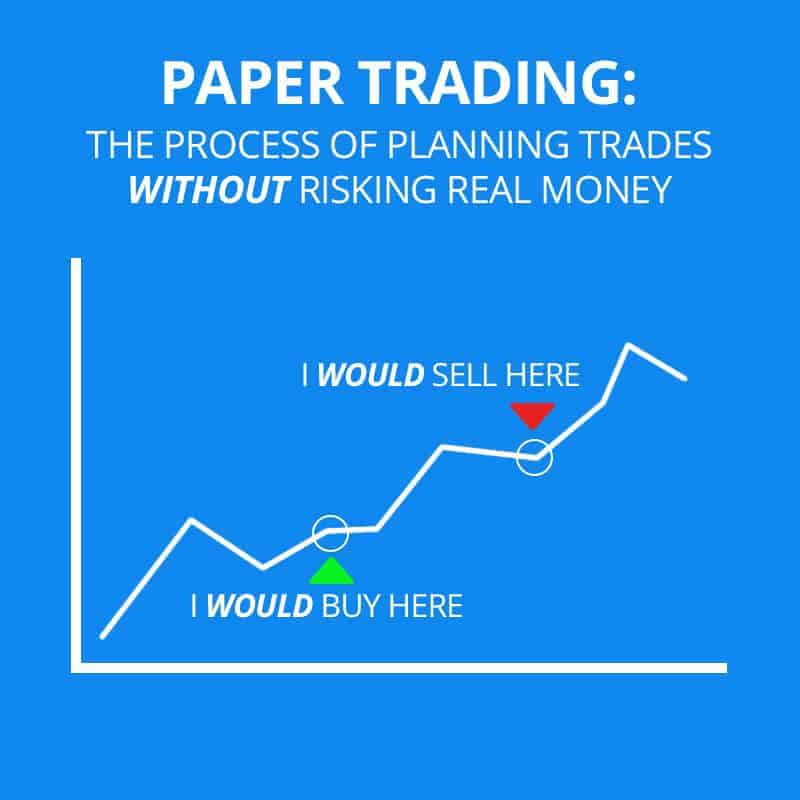It’s common for traders to get a feel of the market without risking real money. Paper trading is one of the options available that allows novice and experienced traders to perfect their trading skills away from the stress that comes with trading live market conditions.
What is Paper Trading?
Paper trading is a risk-free trading strategy whereby traders simulate the opening and closing of positions without using actual money. It’s whereby traders get to test out a trading opportunity to see how trade would perform in real-time. Hypothetically, it is a practical way to trade without risking a cent of capital.
Being a risk-free form of trading is highly useful for beginners who want to learn the ropes of trading. Similarly, experienced traders leverage paper trading from time to time while trying out a new trading strategy. The idea is to learn a new process of trading or try new things to see if positions merit.
While some traders deploy the paper trading strategy by writing down a potential trade and then seeing how the market plays out, others take a life-like approach. There are brokerage firms that offer paper trading accounts ideal for mastering basic trading strategies without risking any amount of money.
Paper Trading Accounts
At the heart of paper trading, are demo accounts offered by most brokerage firms. The demo accounts provide traders with virtual money that can be used to trade real-time markets but risk-free. The accounts come with the functionality of live trading accounts. The main difference being traders don’t get to risk actual money.
Paper accounts or demo accounts are highly advanced as they accurately simulate the live trading environment. Most paper accounts allow traders to access trading indicators as well as charts ideal for carrying out technical analysis.
Real Money Trading Vs. Paper Trading
Paper trading differs from live trading because it provides traders an opportunity to learn the ropes of trading and test different setups without risking actual money. In this case, traders learn how to execute trades risk-free.

The road to success in trading is treacherous. It includes making lots of mistakes and trying out new strategies, all in the effort of perfecting different trading strategies. Likewise, paper trading allows traders to do everything and try anything without stressing about losing money.
With real money trading, the stakes are usually high. The room for errors is minimal, given that one’s capital or actual money is at stake with the placement of each trade or trying out a new set up.
While paper trading provides a way of learning the ropes of trading, it is essential to note that it can sometimes diminish a trader’s need to manage emotions. While there is real value in learning different setups risk-free, the lack of emotions can be misleading. Emotions are a vital element in live trading that influence decision making.
While paper trading, rarely do traders crumble or succumb to emotions as there is usually nothing at stake. However, with real money trading, things change, and decision-making becomes highly driven by underlying emotions.
Why Do You Need Paper Trading
Paper trading acts as an ideal foundation for gaining the much-needed experience for navigating the capital markets. Paper trading provides a way of balancing things from finding a strategy that fits oneself to scanning trading opportunities and learning how to enter and exit positions.
One of the reasons people engage in paper trading is to test new strategies and setups without worrying about losing money. Even if you have some experience under your belt, paper trading is a risk-free way of testing a new strategy to see how it would work out in a real account.
Likewise, paper trading provides a way of studying and learning different chart patterns. It would also be the best time to master various indicators used in price action analysis and the main benefit of fundamental analysis.
After experiencing long losing periods, it is advisable to take a break from live market trading to analyze why things are not working out. Likewise, paper trading provides a way to regain confidence in the market after a long losing streak. Even the most experienced traders struggle and, at times, take a back seat by downgrading into paper trading.
Paper trading stands out because it offers a risk-free way of gaining experience when it comes to trading. With demo accounts, there is plenty of room for failure and learning. Paper trading also eliminates stress and other psychological factors synonymous with live trading.
Going Live
The end game with paper trading is transitioning and starting to trade real money. Paper trading is an avenue of gathering the much-needed experience and confidence to make the big leap into trading using real money.

However, the same should only be done after gathering much-needed skills and perfecting setups to trade different securities and market conditions. Likewise, the transition should only come into play after seeing some blistering performance in a paper account.
A good rule of thumb to remember while making the big leap into live market trading is to halve expectations. Most of the time, traders perform worse in live market trading than is the case in paper accounts. Halving expectations provides the much-needed buffer for protecting oneself against the disappointments that may crop up from time to time.
While in the transition phase, it is essential to start risking small amounts of capital. This way, you will be able to get a feel of the market while managing expectations. Size increment should only come into play when it becomes clear that a given trading strategy can generate significant profits at low risk.
After gaining some experience in a real market environment, it would be wise to compare performance with how you did in paper trading. If there is a small difference, then it means you are in the right trajectory to success. In case of a massive difference, now would be the best time to take a back seat and analyze what is not working and how to correct it.
The Bottom Line
Paper trading provides an ideal way and environment for new participants to learn the intricacies of trading risk-free. For novice traders and beginners, it is advisable to spend a considerable amount of time paper trading, trying out new ideas and strategies before risking actual capital in live markets.
A transition to live market trading should only be made when one is confident about their newly acquired skills and ability of trading strategies and set up to work in live market trading.
However, it is essential to note that paper trading has limited value as it underplays the impact of emotional reactions as a critical factor in live trading. Likewise, paper trading can result in false confidence in the market.




